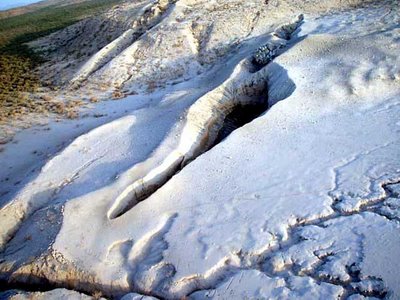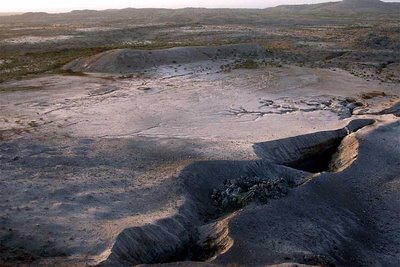Return to Arbonia

The Arbonian Sea is back in the news – and it's got Hollywood written all over it:
"Geologist Dereje Ayalew and his colleagues from Addis Ababa University were amazed – and frightened. They had only just stepped out of their helicopter onto the desert plains of central Ethiopia when the ground began to shake under their feet. The pilot shouted for the scientists to get back to the helicopter." [extreme close-up; words inaudible]
"And then it happened: the Earth split open. Crevices began racing toward the researchers like a zipper opening up. After a few seconds, the ground stopped moving, and after they had recovered from their shock, Ayalew and his colleagues realized they had just witnessed history. For the first time ever, human beings were able to witness the first stages in the birth of an ocean."
[title screen]

[Image: Anthony Philpotts].
However, ocean is a blatant exaggeration; it's a sea, really – the Arbonian Sea. It will simply pry off the Horn of Africa, and form a kind of parallel Red Sea in the space left behind. It's not destined to be a new Indian Ocean, or a new Atlantic. Even a Mediterranean, for that matter.

[Image: Dereje Ayalew/Addis Ababa University].
Yet every time geologists return to study the area, "new crevices are discovered. Fumes as hot as 400 degrees Celsius (752 degrees Fahrenheit) shoot up from some of them; the sound of bubbling magma and the smell of sulphur rise from others. The larger crevices are dozens of meters deep and several hundred meters long. Traces of recent volcanic eruptions are also visible."
This is all screaming for a BLDGBLOG field-trip. (Funders be in touch!)

[Image: Asfawossen Asrat].
The whole region, called the Afar Triangle, is "sinking rapidly. Large areas are already more than 100 meters (328 feet) below sea level. For now, the highlands surrounding the Denakil Depression prevent the Red Sea from flooding these areas, but erosion and tectonic plate movement are continually reducing the height of this natural barrier."
So if the next James Bond is worth its snuff it will feature a crazed geotechnic engineer bulldozing new flood paths through those highlands, ready to flood the valley... Where Britain has some kind of outpost... A space program... A germ warfare lab...
Or maybe it's Bond doing the bulldozing...

[Image: Tim Wright/University of Oxford].
In any case, the Denakil – or Danakil – Depression sounds like paradise to me. Not only does it have the hottest average temperature on earth – it "tops 34°C every day of the year and soars to 55°C in the summer" – but it is chock full of "geological treats." For instance, New Scientist tells us, a "splendid shield volcano more than 50 kilometres wide called Erte Ale occupies much of the depression. The volcano is one of the few in the world with an active lava lake. Nearby, volcanic smoke holes have created crystal pools, lava cones called hornitos and colourful structures formed from sulphur, halite and other minerals. Elsewhere the floor is littered with marine reefs, silt plains and ancient shorelines."
Add all to that the nearby Arbonian Sea, and it seems a good time to be terrestrial, indeed.
(Thanks, Alex!)





Comments are moderated.
If it's not spam, it will appear here shortly!
Very Cool Post! I especially like that first picture. Give you a good sense of the place and the magnitude of what's going on.
I think it's so fascinating! The Earth is in constant motion and change. When the grounds cracks like this it reminds us of its past evolution and makes us dream about its future. What will it look like in millions years from now?
Post a Comment